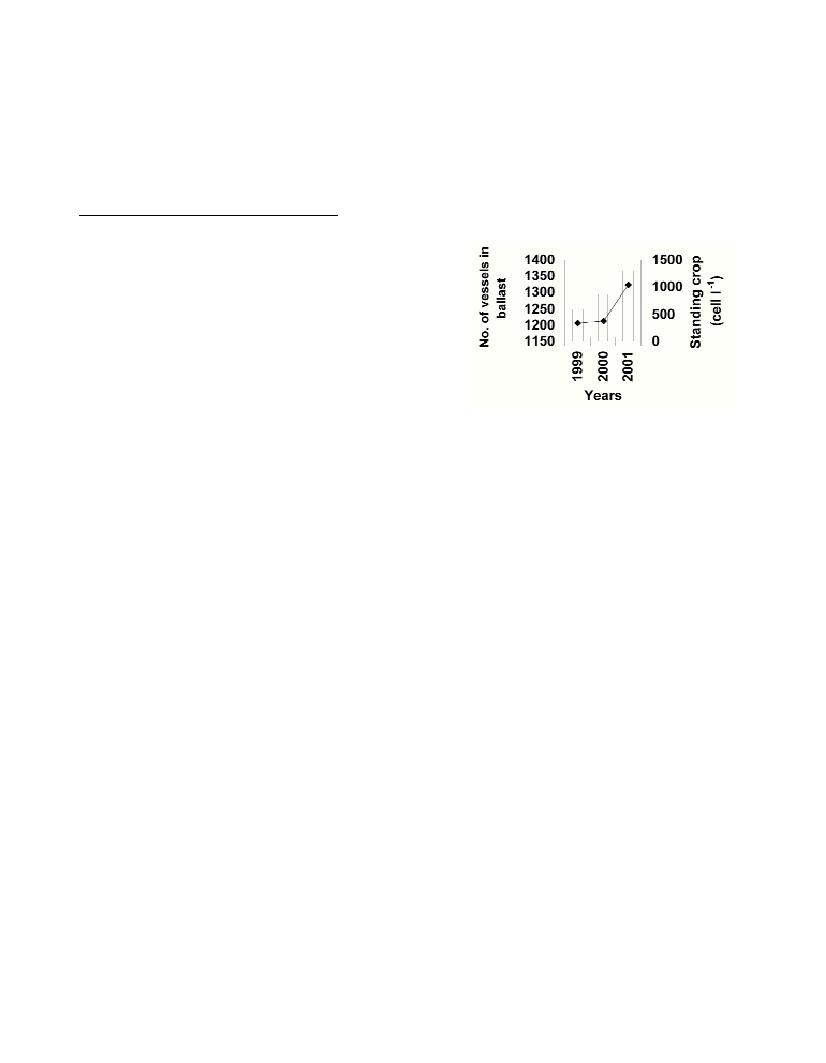PHYTOPLANKTON OF THE GULF OF SUEZ AND THE EFFECT OF BALLAST WATER
Halim Y.
*
and A.A. Ismael
Department of Oceanography, Faculty of Science, Alexandria, Egypt - * youssefhalim@hotmail.com
Abstract
The phytoplankton population in the Suez Gulf consists of 171 species and varieties belonging to 8 groups. The Gulf is an oligotrophic
basin, affected by two man-made factors: turbidity caused by powerful ship propellers and the release of waste and ballast water from
ships, respectively a negative and a positive factor. The latter factor creates micro-environments where brackish water species thrive. This
effect was clear even at stations located far away from the coast and from any land-based sources.
Key words: Phytoplankton, ballast water, Suez Gulf
Rapp. Comm. int. Mer Médit., 37,2004
522
The Gulf of Suez extends 300 km to the northwest of the Red Sea
proper and is connected to the Mediterranean by the Suez Canal. Up
to 76 standard ships cross the canal per day (1). Very little is known
about the phytoplankton of this Gulf (2, 3). Quantitative and
qualitative samples were collected from April 1999 to May 2001 from
thirteen stations, which differ regarding their location relative to the
navigating Channel, to their proximity to the coast and regarding their
total depth.
The Gulf phytoplankton consisted of 171 species and varieties
belonging to 8 groups (Dinophyceae, 88 sp., Bacillariophyceae 69 sp.,
Chlorophyceae 5 sp., Cyanophyceae 4 sp. and Prymnesiophyceae 2
sp., Cryptophyceae, Euglenophyceae and Chrysophyceae with a
single species each). The phytoplankton populations in both northern
(St 1 to 3) and intermediate zones (St 4 to 8) present similarities, but
the southern zone (St 9 to 13) is different. The dino?agellates are
more diversified in this latter zone, contributing 65 % to the total.
Eleven dino?agellates were restricted to this zone throughout the
period of study, especially at the offshore stations. They are true
indicators of surface Red Sea influx: Amphisoleniabidentata,
Citharistes regius, C. de?exum, C. re?exum, Dinophysis monacantha,
Gyrodinium nasutum, Noctiluca scintillans, Parahistoneissp.,
Phalacroma ovum, Pyrocystis fusiformeand Pyrodinium bahamensis
var compressum. Pyrodinium bahamensisvar compressumrecorded
only from the southern zone, is known however to have reached the
Mediterranean at Port Said (4). Several species, which are charac-
teristic of the open Red Sea and the Indian Ocean became adapted to
the Gulf waters and extend to the northernmost Gulf (St 1): C. breve,
C. humileand Protoperidinium sinaicum.
Ceratium egyptiacum, described from the Bitter Lakes (5) in the
Suez Canal, remains endemic to the Gulf of Suez, the canal and the
East Mediterranean up to Lebanon (6) and to Turkish waters (7). It is
not known from elsewhere, either in the Red Sea or the Mediterranean
(8,9).
As the Gulf of Suez is an oligotrophic basin, the standing crop was
very low (84 to 9900 cell l
-1
). It is less affected by natural conditions
than by two man-made factors: turbidity caused by ship propellers
and waste water release from ships. The first factor is negative as
turbidity inhibits photosynthesis while the second enhances
production. An unexpected observation is the occurrence on many
occasions of fresh water and brackish water species in this
high salinity Gulf (average 42 psu): Cyclotella meneghiniana,
Euglenasp., Merismopediasp., Nitzschia closterium, Oscillatoria
sp., Pandorinasp., Pediastrumsp., Spirulinasp., Staurastrumsp. and
Synedra ulna. Brackish species occur at stations scattered along the
north-south axis, ranging in standing crop from 18 to 6250 cell l
-1
.
Their appearance is not related to season or location, but to the
release of ship ballast and waste water causing local enrichment in
nutrient salts. Ballast water therefore creates micro-environments of
low salinity in the Gulf, where alien species thrive. The relation is
positive between the average standing crop of brackish water species
and the average vessels in ballast (Fig.1).
References
1-Suez Canal Authority. 2001. Yearly reports, Egypt, 87 p.
2-Cleve. P.T.1903. Report on plankton collected by Mr. Thorild Wulff
during a voyage to and from Bombay. Ark. Zool. Stockholm, 1: 329-381.
3-Ostenfeld, C.H. and J.Schmidt. 1901. Plankton fra det Röde Hav Aden
bugten. Vidensk. Medd. Naturh. Foren., Kjobenhaven: 141-182.
4-Halim, Y. 1970. Microplankton des eaux egyptiennes. III-Especes
indopacifiques ou erythreennes a l’extreme nord du Canal de Suez.
Journées Etudes Planctonol. Rapp.P-V. Reun. int. Explor. Scient. Mer
Médit.: 57-59.
5-Halim, Y. 1963. Microplancton des eaux égyptiénnes. Le genre
CeratiumSchrank (Dino?agellés). Rapp.P-V. Reun. int. Explor. Scient.
Mer Médit.: 17(2):495-502.
6-Lakkis, S. 1998. Dino?agellate assemblages from the Lebanese
seawater (Eastern Mediterranean). Abstract, the Sixth International
Conference on Modern and Fossil Dino?agellates, Trondheim, Nor-
way: 89.
7-Koray, T., Gokpinar, S., Yurga, L., Turkoglu, M. and S. Polat. 1999.
Microplankton species of Turkish Seas. http:// bornova.ege.edu.tr
8-Dowidar, N.M. 1971. Distribution and ecology of Ceratium
egyptiacumHalim and its validity as an indicator of current regime in the
Suez Canal. Int. Revue ges. Hydrobiol., 56: 751-760.
9-Dowidar, N.M. 1972. Morphological variations in C. egyptiacumin
different natural habitats. Marine Biology, 16: 138-149.
Fig. 1. Average vessels in ballast and average standing crop of brackish
water species in the Suez Gulf.

